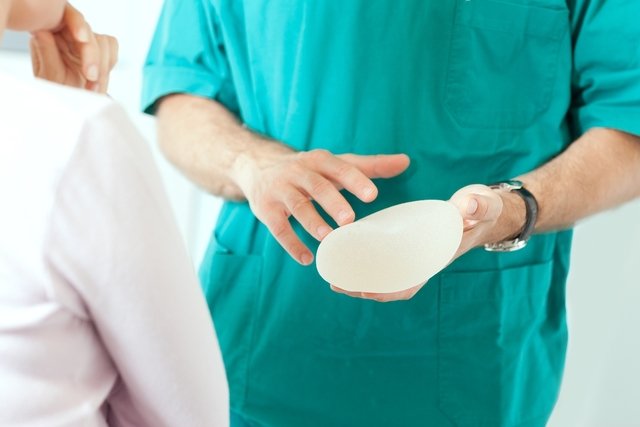Cosmetic surgery to place a silicone implant may be indicated when a woman has very small breasts, is afraid of not being able to breastfeed, has noticed a reduction in size or has lost a lot of weight. But it can also be indicated when a woman has breasts of different sizes or has had to have her breast or part of her breast removed due to cancer.
This surgery can be carried out from the age of 15 with parental authorization, and is carried out under general anesthesia, taking around 45 minutes, and can be done with a short hospital stay of 1 or 2 days, or even on an outpatient basis, when necessary. is discharged on the same day.
The most common complications are chest pain, decreased sensitivity and rejection of the silicone prosthesis, called capsular contracture, which may occur in some women. Other rarer complications are rupture due to a strong blow, hematoma and infection.
After deciding to have silicone implants in her breasts, a woman should look for a good plastic surgeon to carry out the procedure safely, thus reducing the risks of the surgery.

How breast augmentation is performed
In breast augmentation or plastic surgery with a silicone prosthesis, a small cut is made in both breasts around the areola, in the lower part of the breast or even in the armpit where the silicone is introduced, which increases the volume of the breast.
After the cut, the doctor gives stitches and places 2 drains through which the liquids that accumulate in the body exit to avoid complications, such as hematoma or seroma.
How to choose silicone prosthesis
Silicone implants must be chosen between the surgeon and the woman, and it is important to decide:
- Prosthesis shape: which can be drop-shaped, more natural, or round-shaped, more appropriate for women who already have some breasts. This round shape is safer because the teardrop shape is more likely to rotate inside the breast, becoming crooked. In the case of a round prosthesis, a natural shape can also be achieved by injecting fat around it, called lipofilling.
- Prosthesis profile: it can have a high, low or medium profile, and the higher the profile, the more perky the breast becomes, but also a more artificial result;
- Prosthesis size: It varies according to the woman’s height and physical structure, and it is common to use 300 ml prostheses. However, implants weighing more than 400 ml should only be placed in tall women, with wider chests and hips.
- Prosthesis placement location: silicone can be placed above or below the pectoral muscle. It is best to place it over the muscle when you have enough skin and fat to have a natural appearance, while it is recommended to place it under the muscle when you have practically no breasts or are very thin.
Furthermore, the prosthesis can be made of silicone or saline and can have a smooth or rough texture, and it is recommended to use cohesive and textured silicone, which means that if it breaks, it will not disintegrate and reduces the risk of infection. , with fewer chances of developing rejection, infection, and the silicone leaving the breast. Nowadays, completely smooth or overly textured prostheses seem to be the cause of a greater number of contractures or rejection.
How to prepare for surgery
Before undergoing silicone implant surgery, it is recommended:
- Take blood tests in the laboratory to confirm whether it is safe to perform the surgery;
- ECG From 40 years old it is recommended to perform an electrocardiogram to check that the heart is healthy;
- Take antibiotic prophylactic, such as Amoxicillin the day before surgery and adjusting the doses of current medications as recommended by the doctor;
- Quit smoking at least 15 days before surgery;
- Avoid taking some medications such as aspirin, anti-inflammatories and natural medicines in the previous 15 days, as they may increase bleeding, as recommended by your doctor.
On the day of the surgery, you must fast for around 8 hours and during your stay, the surgeon will be able to mark the breasts with a pen to outline the surgical cut sites, in addition to deciding the size of the silicone implants.
What is recovery like from surgery?
The total recovery time from breast augmentation is about 1 month and the pain and discomfort slowly decreases, and 3 weeks after surgery you can usually work, walk and train without exercising with your arms.
During the post-operative period you may have to have 2 drains for around 2 days, which are containers where excess blood accumulated in the chest drains to avoid complications. Some surgeons who perform infiltration with local tumescent anesthesia may not need drains. To alleviate the pain, analgesics and antibiotics are administered.
Furthermore, it is necessary to maintain some precautions, such as:
- Always sleep on your back during the first month, avoiding sleeping on your side or stomach;
- Wear an elastic bandage or stretchy bra and comfortable to support the prosthesis for at least 3 weeks, not even taking it off to sleep;
- Avoid making too many movements with your armssuch as driving or intense exercise, for 20 days;
- Only take a full bath normally after 1 week or when the doctor recommends it and do not wet or change the dressings at home;
- Remove stitches and bandages between 3 days and a week at the medical clinic.
The first results of the surgery are noticed immediately after the surgery, however, the definitive result should be seen within 4 to 8 weeks, with invisible scars.
What does the scar look like?
Scars vary depending on where the cuts were made in the skin, and it is common to have small scars in the armpit, lower part of the breast or on the areola, but these are normally very discreet.
Possible complications
The main complications of breast augmentation are chest pain, hard breasts, a feeling of heaviness that causes a hunched back and decreased sensitivity in the breast.
Hematoma may also appear, which causes swelling and redness of the breast and, in more serious cases, hardening may occur around the prosthesis and rejection or rupture of the prosthesis, which leads to the need to remove the silicone. In very rare cases, there may also be infection of the prosthesis. Before undergoing surgery, find out what the main risks of plastic surgery are.
Frequently asked questions about mammoplasty
Some frequently asked questions are:
1. Can I have silicone before getting pregnant?
Mammoplasty can be done before becoming pregnant, however it is common for the breast to become smaller and droopy after breastfeeding, and it may be necessary to undergo further surgery to repair this problem, which is why women often choose to have breast implants after breastfeeding.
2. Do I need to change the silicone after 10 years?
In most cases, silicone breast implants do not need to be changed, however it is essential to go to the doctor and undergo tests such as MRI at least every 4 years to check that the implants have not changed.
However, in some cases the prostheses may need to be changed, mainly occurring 10 to 20 years after their placement.
3. Does silicone cause cancer?
Studies carried out around the world indicate that the use of silicone does not increase the chances of developing breast cancer. However, you must inform your doctor that you have a silicone implant when undergoing a mammogram.
There is a very rare breast cancer called giant cell lymphoma of the breast that may have something to do with the use of silicone implants, but due to the small number of cases recorded in the world of this disease it is difficult to know for sure whether this relationship exists.
In most cases, performing breast augmentation and surgery to lift the breasts brings better results, especially when the woman has sagging breasts. See how mastopexy is performed and learn about its excellent results.

Sign up for our newsletter and stay up to date with exclusive news
that can transform your routine!
Warning: Undefined array key "title" in /home/storelat/public_html/wp-content/plugins/link-whisper-premium/templates/frontend/related-posts.php on line 12
Warning: Undefined array key "title_tag" in /home/storelat/public_html/wp-content/plugins/link-whisper-premium/templates/frontend/related-posts.php on line 13



